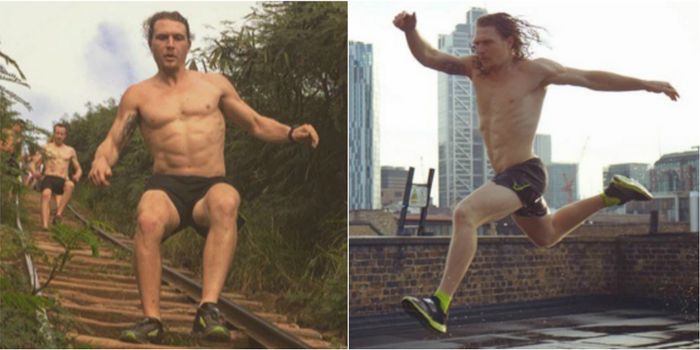If you want to know how to train to smash any obstacle course race, you could do worse than asking Tim Shieff.
He’s a professional Parkour athlete, UK Ninja Warrior champion, and climber who likes to do obstacle races for the sheer hell of it. Oh, and he’s a vegan too.
The man is damn good at them too. He’s an absolute machine to begin with, having won the World Freerunning Championships in 2009, and then captaining the European Ninja Warrior team to victory over the US five years later.
But 18 months ago the athlete took up traditional running, which added a new and potent dimension to his fitness.
His prowess in the domains of Parkour and running made Shieff an ideal athlete for Obstacle Course Racing (OCR), and he’s already making a big impact on the sport.
https://www.instagram.com/p/BCbXjV7TJ2r/?taken-by=humantimothy
Shieff is now deep in training to take on Toughest – a Nordic obstacle course race which débuts in London on April 23.
Obviously Shieff has incredible core strength, athletic power and gymnastic ability from his Parkour, which translates incredibly effectively over to OCR.
But the OCR training he does is actually incredibly simple. It consists of two key disciplines to prepare his body to take on races like Toughest, which he says anyone can incorporate into their training programme.
“The two most important elements of training you can do for this sport are rock climbing and running,” he told JOE.
Climbing helps Shieff develop his upper body strength as well as his lower body and arms, meaning he can be strong and agile over many of the obstacles.
Focussing on running has also helped Shieff build his cardio engine for covering the 8km course distances as fast and as efficiently as possible.
His weekly training programme is also very straight forward and geared up to build his strength, skill and conditioning.
https://www.instagram.com/p/_GosmvTJ5O/?taken-by=humantimothy
“I’m doing rock climbing two or three times a week,” he says. “Then I’m running five or six times a week.”
It’s not just a case of pounding the pavements like an old school boxer or getting the miles in like a marathon runner.
He will do one long run for volume, a tempo run, an interval session and a relaxed run around race day – which could be a OCR, a half marathon, 10k or even just a Park Run 5k.
It’s Shieff’s interval training sessions that are particularly key to his performance and success at OBR.
Tuesday he will visit the track to do his intervals, which consist of a set distance followed by a set rest period, repeated over a number of rounds.
“I do mid-distance intervals. But I think I will probably start doing more sprint distance intervals for my obstacle racing.
“It’s a lot more race specific – so a lot more 200m and 400m intervals. At the moment I’m running 400m to mile intervals on the track.”
https://www.instagram.com/p/wEiqfrzJz9/?taken-by=humantimothy
Interval training is a fast and efficient way of building up your cardio and your capacity to run and recover over set distances.
It’s an intelligent approach to a race format where athletes have to run a set distance between obstacles.
Shieff tailors his interval training to suit the different OCR challenges he takes on.
“It depends what race I’ve got coming up,” he explains. “I’m always in decent shape and then I will choose peak races and then I will train specifically for that.
“So with Toughest coming up on April 23, I will probably do 400m intervals with some burpees in between each set of 400m, so that you’re working all your engines and hitting your upper body in between the runs.”
“Off season I’m running 800m or 1km intervals, because I love my long distance and trail running and I don’t need the speed as much.
“The Toughest is obviously a lot shorter distance and you’re stopping in between runs for obstacles. So you need to get used to and train for ‘Obstacle, sprint off. Obstacle, sprint off.’ It’s logical to train that way really.”
https://www.instagram.com/p/70JHpHTJ7I/?taken-by=humantimothy
Even when he’s out for a long run though he won’t neglect the upper body strength that helps him surmount the obstacles with ruthless ease.
Every other day he will do what he calls a ‘Fibonacci set’ of exercises on the pull up bar (named after the classic mathematical sequence).
So he will do 10-7-6-5-5 reps on pull-ups and then 8-6-5-4 reps on chin-ups to keep his ‘pull’ strength ticking over nicely.
But just as important as the strength and conditioning work he does over a week, Shieff devotes a day to active recovery which means he can keep up his high volume training without burnout or injury.
It comes in the form of Bikram Yoga – a series of yogic postures and breathing exercises conducted in a heated room. He goes every Monday to start his week and swears by it.
“It’s for blood flow,” he explains. “Normally I will race and then do a long run on the Saturday and Sunday, so the peak of the week is Friday, Saturday, Sunday, and then Monday comes around and it’s a new week, and I will start it with some yoga just to flush the lactic out of my muscles.
“You get trapped energy in there and stiffness, and it just flushes it out because you’re in every angle and every position and the blood is pumping.
“I feel fresh after that on a Monday and I can start the week. I get into my training hard and probably climb again that night.”
https://www.instagram.com/p/-SlXM0zJ1i/?taken-by=humantimothy
That’s a high-training volume for anyone in a week – but Shieff says the combination of climbing and running prepares him perfectly for the challenges posed by OCR racing.
So why does he think it’s so effective?
“It’s being light on your arms, because you’ve got to carry stuff and climb up and down stuff. So you have to be really nimble, and even when you’re tired and your lungs are burning you can still climb obstacles.
“Obviously there’s obstacles you can do if you’re fresh and you’ve not been running. But when you’re tired and blowing out of your arse you still have to be able to do them fast.”
Interestingly Toughest courses offers racers two different lanes with different obstacles to tackle – a ‘normal lane’ and a ‘fast lane’.
“That’s the beauty of what Toughest do,” he says. “What it offers racers is two lanes of obstacles.
“You can see how you feel at that point in the race. Do you want to take the harder route? Have you got enough energy? Or do you want to play it safe and take the easy route and just run the extra 200m after that?
“That’s the unique thing they offer that no other obstacle race has, and that’s what drew me to them.”
https://www.instagram.com/p/BB9pf8OTJxP/?taken-by=humantimothy
There’s no real secret to what he does – and Sheiff reckons anyone has the capability to do well at OCR.
“They’re always 8km,” he points out. “If you can run 5km, then you can make 8km. It’s not too far. Then you’ve got options for the obstacles.”
He adds: “You’ve just got to turn up. You look at half the people that do them and they just turn up with no training, no gear, and they just come and get through it. You’re like ‘fair play!’”
Tim Shieff will be taking part in Toughest on April 23. To join him please visit www.toughest.se





















































